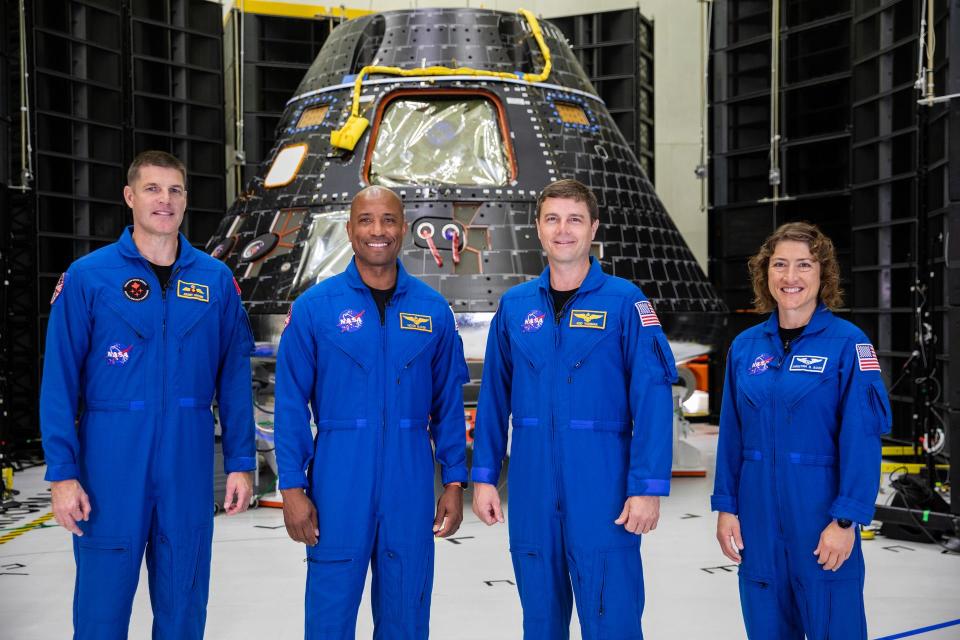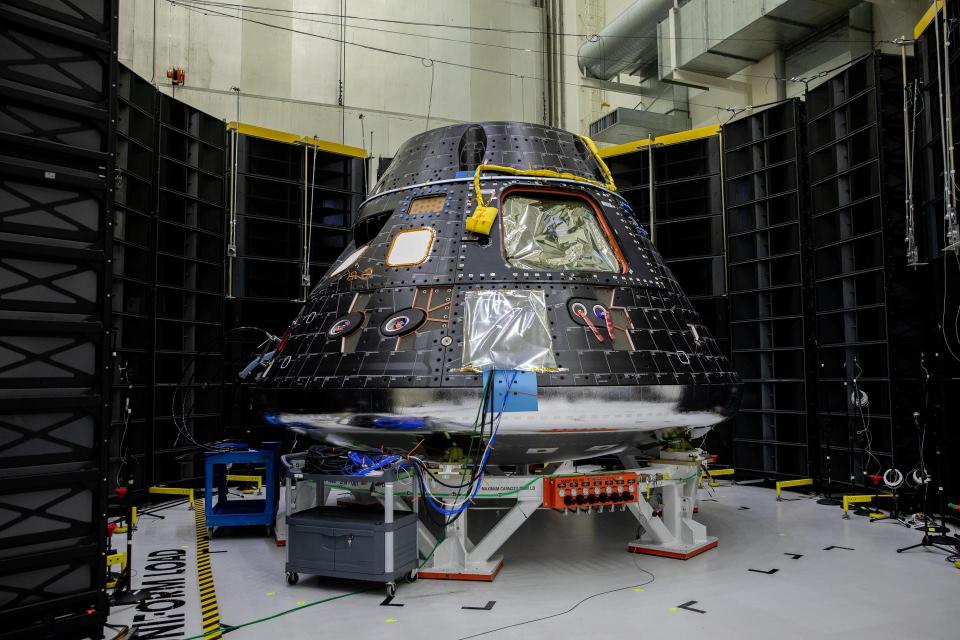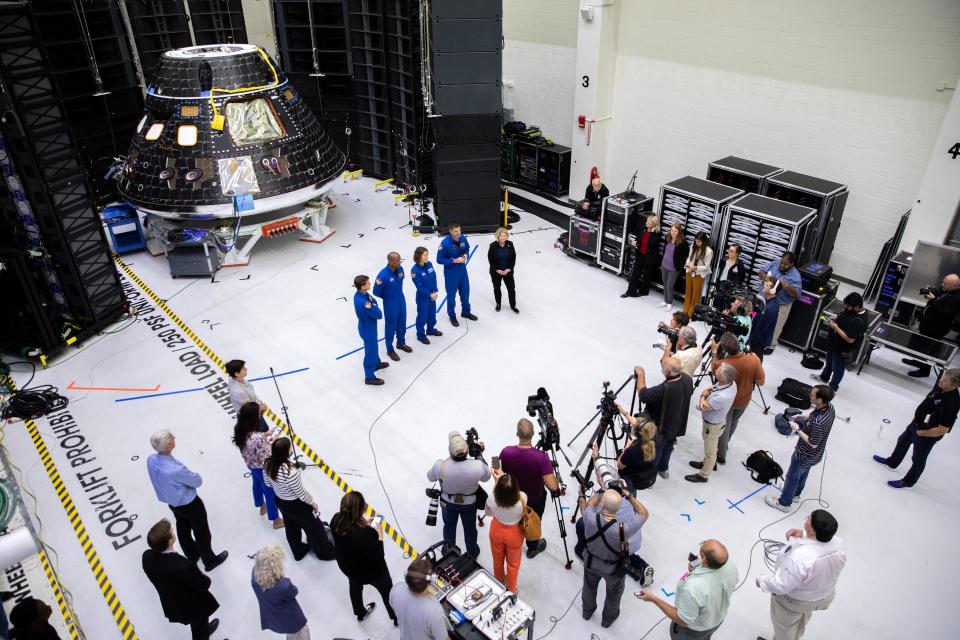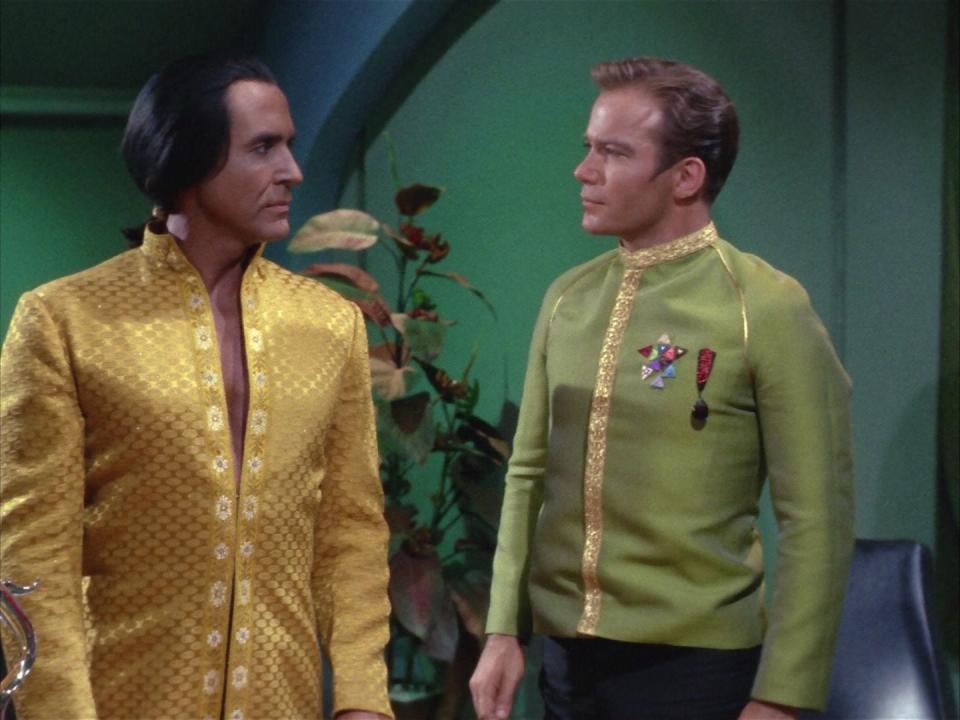In an age of cynicism, Artemis astronauts seem extraordinary heroes to this '70s child
- Oops!Something went wrong.Please try again later.
- Oops!Something went wrong.Please try again later.
- Oops!Something went wrong.Please try again later.
- Oops!Something went wrong.Please try again later.
As a little kid growing up in the ‘70s, one who walked around with a briefcase stuffed with comic books, my knowledge of space travel was limited to the Justice League’s interstellar battles with Starro the Alien Conqueror and stories about the brooding Martian Manhunter.
Sure, we learned about astronauts like Neil Armstrong and Buzz Aldrin landing on the moon, but to that 6-year-old, wrapped in a bedsheet for a cape, they weren't Batman, if you get my drift.
Five decades later, and far removed from those hot southern summers leafing through the comic books with my best friend Antoine, I found myself standing a few feet away from a new set of real-life heroes.
The Artemis II’s four-member crew — decked out in their crisp, electric-blue flight suits — stepped into the Neil Armstrong Operations and Checkout Building this week at the Kennedy Space Center to look at the unfinished Orion crew module as reporters looked on. In late 2024, if schedules hold, this same fantastic four will be vaulted from the hot, swampy shoreline of Cape Canaveral into the darkness of space, traveling farther than any human has gone before.
This is going to happen, I thought to myself as I listened and watched the crew talk about the mission, their training, hopes, fears and expectations. And it’s definitely as cool as the story of Superman leaving a dying Krypton.

The astronauts — Commander Reid Wiseman, Pilot Victor Glover, Mission Specialist Christina Hammock Koch and Mission Specialist Jeremy Hansen, the latter of whom is from Canada — will loop around the moon in the Orion capsule before returning to Earth. This will provide NASA, and its partners, the European and Canadian space agencies, with a transitional mission that will set the space program on a path to return to the moon permanently before venturing onward to Mars.
That is truly amazing.
But the ambitious, 10-day mission is also a rebirth of sorts, heralding a renaissance era for the space agency, coming nearly six decades after the nation’s first moon landing.
We see the space-studded stories of universe mapping carried out by the James Webb Space Telescope, the embryonic start to space tourism, the increased frequency of rumbling launches from the Cape, the building of the Gateway Space Station and the rover missions to the craggy surface of the red planet.
However, the crown jewel of the space program will be the $93 billion Artemis moon missions. NASA wants to reignite that inspiration for younger generations — a weary set who've grown up in the shadow of the Sept. 11 attacks and lived through a killer pandemic, social media and endless geopolitical wars. They want millennials and those younger to believe in the age-old dream to live among the stars. And it's getting closer to reality, as reporters saw, walking through and looking over the Orion, surrounded by stereo speakers set to test its capability to stay intact during a 140-decibel blast.
“It’s a pretty inspiring moment,” Wiseman said as he and the crew stood in front of the Orion capsule along with others, including teams from Lockheed Martin looking on.
The crew — growing into their roles as heroes, true guardians of the galaxy, in an age of cynicism and political scandal — was chatty, deferential and enthusiastic as they volleyed questions.
"It's exciting and amazing to see the handiwork," said Glover, who thanked journalists for getting word out about the mission.

The day was part of a media walkthrough bolstering awareness of the program and its historic impact. NASA, of course, is also battling the villain of public indifference. The nonprofit Pew Research Center conducted a poll that shows just 12% of Americans think that getting astronauts to the moon is a priority. Going to Mars? That number is even smaller, with only 11% of people thinking NASA should make the effort.
The idea of space travel was once a grand unifier.
When Armstrong set foot on the grayish surface of the moon, people across the globe gathered around TV sets to watch. Throughout history and in our personal lives, we romanticize space, thinking wildly at times as the stars glisten against the black velvet sky. We wonder: Will we ever live in space, or have our grandkids shoot hoops in the lower gravity of Mars?
This is why STEM-related education covering science, math, engineering and the latest in technology, is important in developing educational capital, conceptual thinking and innovation. But it's not enough to just read a book. We have to round that out with having students learn and know all aspects of history, working with others from different backgrounds toward common goals.
Apart from the comic books, I first really fell in love with the idea of space exploration and pushing humanity's reach to other planets, at a young age. It was a magical Wizard of Oz moment when my 6-year-old mind went from black and white to color on the idea of traveling in space, and what it could really mean.
More: Passover in Space: Brevard rabbi delivers special matzah to Israeli astronaut in time for holiday
One day, bored with talking about the exploits of our comic book heroes, my cousin Gus flipped on our color TV and said, “Watch this.’ It was "Star Trek." At first, I thought "Ugh, they don’t have any superpowers." But then I found myself staring at the screen, seeing the colorful outfits, the phasers, and hearing Spock speak coolly about logic and science.

This was beyond Batman and Robin. It was all about possibilities. The diverse crew worked together to navigate space, on that storied five-year mission that kept me up late Sunday nights before school days. Some of the diverse crew, like Lt. Uhura, looked like family.
Yes, Spock irritated Dr. McCoy, and Scotty was a little too forward at times, but that's what made those fictional heroes great. They had camaraderie despite the challenges. I loved the fact that during the press conference with NASA Administrator Bill Nelson — also a former astronaut — Glover mentioned that he and the others gathered together with family and even ate at an undisclosed restaurant. "We feel like a family," Glover said.

As a teen in the ‘80s, I still caught the occasional episode of "Star Trek" and didn’t miss a "Star Wars" movie, but my interest in the real space program started to wane by the time I went off to college. However, the spark reignited after my first space shuttle launch assignment in 1996, covering a Columbia mission shortly after moving to Florida to work as a news reporter in Brevard.
After that, I was hooked, looking forward to each launch like it was the first one. It didn’t matter whether I was on assignment; just being in the same county where shuttles pierced the sky was exciting. Ironically, I was also at KSC when the last, ill-fated flight of the Columbia lifted off into the blue sky that January morning 20 years ago.
Over the years, I’ve interviewed Buzz Aldrin, the second man to step foot on the moon, and Sen. John Glenn — the third American in space — along with other astronauts who are true heroes in my book because of their dedication to science and discovery.
The space program, for all of its tragedies and triumphs, no doubt will reach new heights once again as a grand, global unifier. You can just imagine everyone leaning over their cellphones and tablets to watch as humans eventually set foot on the moon again, maybe inspiring a kid or two to put down their video game for a minute to look at the real thing.
While there are no capes or mind-reading Martians, the Artemis crew — with all of their talent, education, critical thinking capabilities and calmness at the idea of being slung across a portion of our universe — is extraordinary.
And they are worthy of our support — and our dreams.
J.D. Gallop is a criminal justice/breaking news reporter at FLORIDA TODAY. Contact Gallop at 321-917-4641 or jdgallop@floridatoday.com. Twitter: @JDGallop.
This article originally appeared on Florida Today: Artemis astronauts: Extraordinary heroes in an age of cynicism

